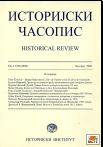Неретљани - пример разматрања идентитета у раном средњем веку
Arentani - an Example of Identity Examination in the Early Middle Ages
Author(s): Tibor ŽivkovićSubject(s): History
Published by: Istorijski institut, Beograd
Keywords: John the Deacon; Constantine Porphyrogenitus; Venetian chronicle; Pagania
Summary/Abstract: Judging by the sources on the Pagani/Arentani/Mariani – who represent the pivotal topic of this research, John the Deacon was an author who had detailed and accurate information at his disposal, which led him to reach certain conclusions regarding the specific issues on the Pagan organization of polity. Pagania, being the important maritime traffic artery, developed and flourished at the turn of millenia, and marked the dawn of a new era, regretfully omiitted by Jonh the Deacon. As for the structure of Pagan polity, it is noticeable that it doubtlessly did not represent a distinctly united political realm in the IXth century. The three regions were prominent – the zupas of Mokro and Rastok, lying along the sea, Dalen, above Biokovo, the island of Brač, and Hvar, most likely. The issue of Mljet and Korčula is questionable. Could it be assumed that the Pagani have simply identified themselves as the Maritime people (Morstici, Mariani) – the people who dwelled by the sea, depended upon the marine resources and the opportunities the sea had to offer them, and who were alluded to as pirats in the Early Middle Ages? The fact that the Pagan archontes did not pay tribute to Byzantium or Venice was rather typical, revealing their relatively strong position. And finally, it might be highly probable that the Pagans, referred to by Porphyrogenitus, have in fact represented the Slavs (judging by the preserved names of their rulers which confirm that hypothesis), who were predominantly described as pirates in the early IXth century, and differentiated from all others - Venetians in the first place. Through time, according to John the Deacon, they were more accurately presented as traders, undertaking journeys across the sea, whose rulers oversaw their Narentanorum nobilium (998), as well as their economic interests. Preservation of the name Arentani, together with that of Morstici, leads to the conclusion that Arentani was a generic name, under which they were more widely known, whereas Mariani designated their occupation. Their contemporaries have presumably known the difference between these two terms.
Journal: Историјски часопис
- Issue Year: 2012
- Issue No: 61
- Page Range: 11-25
- Page Count: 15
- Language: Serbian

